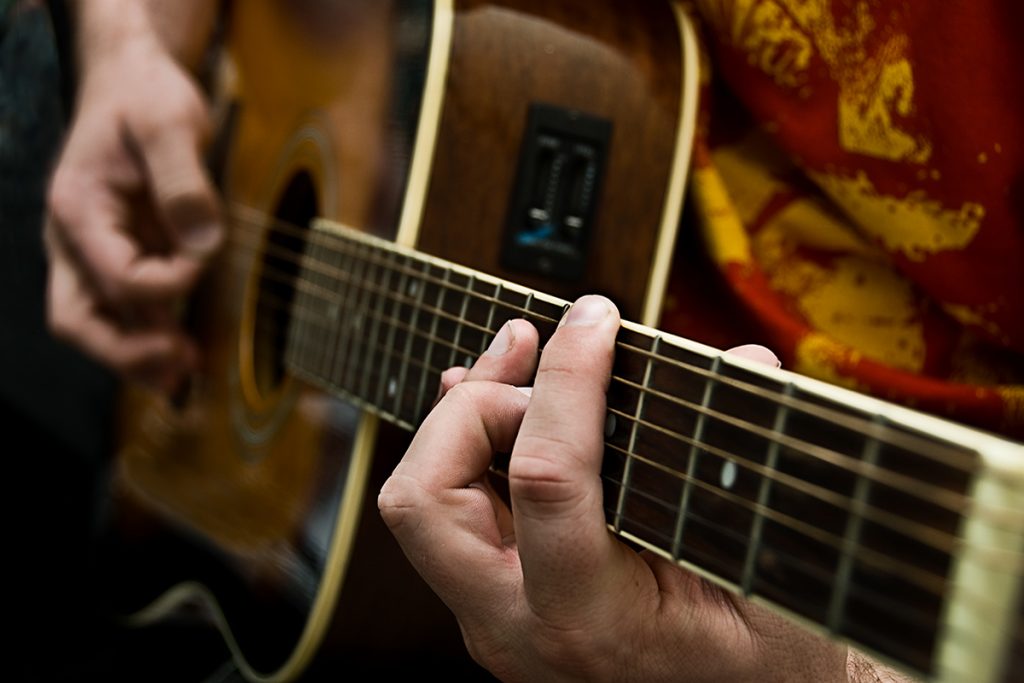How a guitarist plays bluegrass is defined by their rhythm style, runs, and lead. In his latest TrueFire course, Bluegrass Rhythm Evolution, Stephen Mougin will take you through the history of bluegrass, sampling the rhythm patterns of several of the greatest bluegrass guitar players: Carter Stanley, Lester Flatt, Jimmy Martin, Charlie Waller, Tony Rice, and more.
In these free bluegrass guitar lessons, Stephen will give you a sample of ways to apply these rhythm patterns to different classic bluegrass songs. Let’s take a look:
The Role of Bluegrass Guitar – Overview
The rhythm guitar is the “meat and potatoes” of the bluegrass band sound. It provides lots of continuous rhythm as well as plenty of low-mid tonal content. Typically, bluegrass guitar is “boomier” than what would be appropriate in other genres.
Charlie Waller Style Rhythm – Demonstration
Download the tab and notation for this bluegrass guitar lesson on TrueFire.
Charlie Waller’s style seems to be very similar to Jimmy Martin, with the upstrokes, but he very clearly played the alternating bass notes. If the song was in a G shape, he often added a series of quick C shapes between sections of the song.
(User listening tip: “Little Bessie“)
Aunt Dinah’s Quilting Party – Performance
Download the tab and notation for this bluegrass guitar lesson on TrueFire.
As an example of Charlie Waller’s rhythm, let’s play “Aunt Dinah’s Quilting Party.” Charlie Waller’s style seems to be very similar to Jimmy Martin, with the upstrokes, but he very clearly played the alternating bass notes. If the song was in a G shape, he often added a series of quick C shapes between sections of the song.
Aunt Dinah’s Quilting Party – Breakdown
Let’s break down “Aunt Dinah’s Quilting Party.” Charlie Waller’s style seems to be very similar to Jimmy Martin, with the upstrokes, but he very clearly played the alternating bass notes. If the song was in a G shape, he often added a series of quick C shapes between sections of the song.
Tony Rice Style Rhythm: 2 – Demonstration
Download the tab and notation for this bluegrass guitar lesson on TrueFire.
On slower/prettier songs, Rice would often substitute single note “rolls” for the final upstrums in his pattern.
(User listening tip: “Last Thing On My Mind“)
Home Sweet Home – Performance
Download the tab and notation for this bluegrass guitar lesson on TrueFire.
As another example of Tony Rice’s rhythm, let’s play “Home Sweet Home”. On slower/prettier songs, Rice would often substitute single note “rolls” for the final upstrums in his pattern.
Home Sweet Home – Breakdown
Now let’s break down “Home Sweet Home”. On slower/prettier songs, Rice would often substitute single note “rolls” for the final upstrums in his pattern.
Kenny Smith/Ron Block Rhythm – Demonstration
Download the tab and notation for this bluegrass guitar lesson on TrueFire.
For some slower tunes, both of these fantastic stylists will drop to a simple chord arpeggio, sometimes even including some non-chord tones to add color.
As you begin learning this style, don’t worry so much about exactly which notes you’re playing after the downbeat. As long as your left hand is in the correct chord shape, any string you hit will be a “correct” note. When you spend some quality time with it, you can dial in your specific note choice for each pattern or phrase.
(User listening tip: “When You Say Nothing At All” by Ron Block or “Lay This Broken Heart To Rest” Kenny Smith)
If you’re looking for more bluegrass rhythm guitar, make sure to take a look at the rest of the course on TrueFire. There you’ll find even more variations and the tab and notation to play along. Check it out now!
